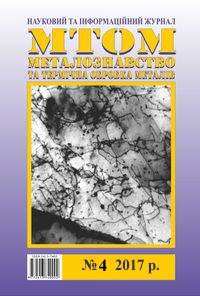Calculation of secondary hardening parameters of high-alloyed iron alloys after integrated chemical-thermal processing
Keywords:
secondary hardening, chemical heat treatment, preallocation zones, high-alloyed iron alloysAbstract
Purpose. It is of interest to investigate the relationship between secondary hardening and microstresses in the crystal lattice on the tempering temperature of iron alloys doped by the principle of high-speed steels after complex chemical-thermal treatment. It is necessary to identify structural transformations in a complex treated alloy of type 20P18 after the final heat treatment (quenching and tempering) by electron microscopic. It is of interest to study the regularities of the formation of preallocation zones of the Guinier−Preston type in high-alloyed iron alloys after the final thermal treatment. Methodology. The materials for investigation was the cast alloy of type 20P18 made on the basis of standard P18 steel with the addition of carbon to ~2 %. The degree of perfection of the crystal lattice of the 20P18 alloy was evaluated after the implementation of complex chemical-thermal treatment (decarburization + carburization) and tempering at various parameters. Methods of research − electron microscopy and optical microscopy. Results. It was found that the maximum lattice tension and high microhardness for the type 20P18 alloy correspond to tempering at temperatures of 550...560 °C. It is shown that fine-dispersed carbides of the M3C type are distinguished in the diffusion layer after tempering, which are also characteristic of standard high-speed steel, but in a larger quantity. The maximum of the secondary hardness of high-alloyed iron alloys corresponds to the stage of formation of the Guinie−Preston preallocation zones, which corresponds to tempering at temperatures of 550...560 °C was established. Originality. It is established that formation zones of the Guinier−Preston in the process of tempering to secondary hardness contribute to the distortion of the crystal lattice of the solid solution. Practical value. The using of the obtained results will allow more flexible control over the final structure of specific products, and, consequently, successfully solve practical problems of improving the technological and operational characteristics of the cutting tools.
References
Пат. 71705 Україна, МПК C21D 9/22. Спосіб комплексної обробки литого металорізального інструменту / Ю. С. Пройдак (UA), О. В. Мовчан (UA), С. І. Губенко (UA), А. П. Бачурін (UA), К. О. Чорноіваненко (UA). – № u2011 15570; Заявл. 29.12.2011; Опубл. 25.07.2012; Бюл. №14. – 4 с.
Черноиваненко Е. А. Получение композитной структуры в приповерхностном слое инструмента на базе литой быстрорежущей стали Р6М5 / Е. А. Черноиваненко, С. И. Губенко, А. В. Мовчан, А. П. Бачурин // Вісник Дніпропетровського університету. – 2011. – № 4. – Т. 19. – С. 188–192.
Губенко С. И. Применение химико-термической обработки с целью повышения стойкости литого режущего инструмента / С. И. Губенко, А. П. Бачурин, Е. А. Мовчан // Вісник Дніпропетровського університету. – № 14. – Т. 2. – 2010. – С. 36–40.
Миркин Л. И. Рентгеноструктурный анализ : индицирование рентгенограмм (справ. руков.) / Л. И. Миркин. – Москва : Наука, 1981. – 796 с.
Горелик С. С. Рентгенографический и электронографический анализ металлов : монография / [С. С. Горелик, А. Н. Расторгуев, Ю. А. Скаков]. – Москва : Металлургия, 1963. – 218 с.
Chinh N.Q. Characterization of plastic instability steps occurring in depth-sensing indentation tests / N. QChinh, Gy. Horváth, Zs. Kovács, J. Lendvai // Materials Science and Engineering : A. – 2002. – Vol. 324. – Issue 1–2. – Pp. 219–224.
Kirkaldy J. S. Statistical self-similarity in Rhines’ concept of unique multiphase diffusion paths on the ternary gibbs’ isotherm / J. S. Kirkaldy, P. Maugis // Metallurgical and Materials Transactions : A. – 2002. – Vol. 33. – Issue 11. – Pp. 3357–3365.
REFERENCES
Yu.S. Proydak (UA), O.V. Movchan (UA), S.І. Gubenko (UA), A.P. Bachurіn (UA) and K.O. Chornoіvanenko (UA). Pat. 71705 Ukraine, MPK C21D 9/22. Sposіb kompleksnoyi obrobki litogo metalorіzal'nogo іnstrumentu [The process of a complex treatment of a cast cutting tools]. Publ. 25.07.2012; bull. no. 14, 4 p. (in Ukrainian).
Chernoivanenko E.A. Gubenko S.I., Movchan A.V. and Bachurin A.P. Poluchenie kompozitnoj struktury v pripoverhnostnom sloe instrumenta na baze litoj bystrorezhushhej stali R6M5 [Receiving of a composite structure in the near-surface layer of a tool based on cast high-speed steel P6M5]. Vіsnik Dnіpropetrovs'kogo unіversitetu. [Bulletin of Dnipropetrovsk University]. 2011, no. 4, vol. 19, pp. 188–192. (in Russian).
Gubenko S.I. Bachurin A.P. and Movchan E.A. Primenenie himiko-termicheskoj obrabotki s cel'ju povyshenija stojkosti litogo rezhushhego instrumenta [Application of chemical-thermal treatment in order to increase the durability of cast cutting tools]. Vіsnik Dnіpropetrovs'kogo unіversitetu. [Bulletin of Dnipropetrovsk University. Series]. 2010, no. 14, vol. 2, pp. 36–40. (in Russian).
Mirkin L.I. Rentgenostrukturnyj analiz: indicirovanie rentgenogramm: (spravochnoe rukovodstvo) [X-ray diffraction analysis: X-ray imaging]. Moscow : Nauka Publ., 1981, 796 p. (in Russian).
Gorelik S.S., Rastorguev A.N. and Skakov Ju.A. Rentgenograficheskij i jelektronograficheskij analiz metallov [X-ray and electron diffraction analysis of metals]. Moscow : Metallurgija Publ., 1963, 218 p. (in Russian).
Chinh N.Q., Horváth Gy., Kovács Zs. and Lendvai J. Characterization of plastic instability steps occurring in depth-sensing indentation tests. Materials Science and Engineering : A. 2002, vol. 324, iss. 1−2, pp. 219−224.
Kirkaldy J.S. and Maugis P. Statistical self-similarity in Rhines’ concept of unique multiphase diffusion paths on the ternary gibbs’ isotherm. Metallurgical and Materials Transactions : A. 2002, vol. 33, iss. 1, pp. 3357−3365.
Downloads
Published
Issue
Section
License
Authors that are published in this journal agree to follow the conditions:
Authors reserve the right to the authorship of his work and cede the right to the journal of first publication of this work on conditions of the license under the Creative Commons Attribution License, which allows others to distribute it freely with the obligatory reference to the author of the original work and the first publication of the work in this journal.

